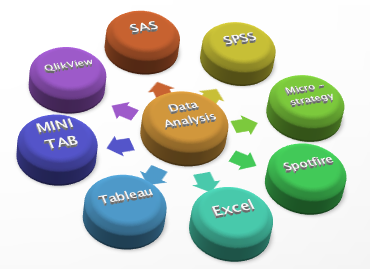What you should know about data analytics?
Wspómodern gold diggers work in front of a computer — data is the new gold. Data analysts are looking for this gold in collections obtained fromóThe authors of this analysis emphasize thatósources: from clientsów, the userów, twórcóin content, generated by machines, sensors, applications. Big Data is applicable in almost every walk of life and in every market segment. It can be used to optimize the processóThe main goal of SMS campaigns is to provide information based on facts, not on impressions or hunches, in order to discover new phenomena and support key decisions.
A lot, or how much exactly?
It is estimated that about 90% of digital data has been generated in the last few years. A large amount of data is the basic feature of the Big Data ecosystem. We no longer operate on gigabytes or terabytes of data, but petabytes. Where one petabyte of music stored in MP3 format would play continuously for two thousand years. Let me give you two examples to illustrate the amount of data generated: YouTube users upload about 300 hours of video every minute, and Google’s search engine handles about 63,000 queries per second.
It is not hard to imagine that this data is very zródifferentiated. Depending on their type and nature, we can divide them into structured and unstructured. Another important thing is extracting value and information not only from tabular data, but róThey also look for it in text, images, audio and video. Big Data is generated at very high speed and róThe new standard in the FinTech sector is already in Warsaw. The information is captured and analyzed basically at the moment it is produced. Small collections are usually updated ad hoc or periodically as needed.
Gathering isn’t everything
Extracting value and knowledge from data requires the right technology and skills. And from companies and organizations, it requires investment in systems and infrastructure, as well as specializedów. What steps should be taken to extract value and knowledge from the chaos of information?
The first step is to collect and make sure the data you need to solve the problem is retrievable. Next, that the data is properly stored, which requires investment in reliable and easily accessible infrastructure. The next step is uploading the data to databases. Incorporate a data transformation element into the process, in order to prepare a set ofóin a user-friendly format. Data engineers and data infrastructure engineers are key at this stage. Then the data analysts come into action. These professionals thoroughly analyze, clean, verify, catch anomalies in the data, and verify that the information gleaned reflects reality and will be applied to solving a problem. Only thus prepared data can be used for analysis, aggregation, segmentation, creation of metrics and recommendations for the business. In subsequent stages, they can be used to train machine learning models.
How to use it?
The process of acquiring Big Data can be time-consuming and expensive, but it is worth every zloty investedówki. Matching marketing campaigns, anti-money laundering, business decision support, medical diagnostics, political preference tracking, route optimization for logistics and courier companies, sports win predictions, autonomous vehicles, or translators are just some of theóre examples of using advanced data analytics in life and business. There is no turning back from digital transformation.
